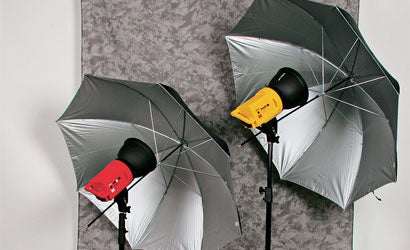Peter Kolonia’s Lighting
F.J. Westcott's Photo Basics lighting kits are training wheels for the studio.

There’s a picture of a teenager on the box, and its colorcoding and extremely clear directions give it a child-friendly simplicity. Yet F.J. Westcott’s new Photo Basics lighting kit (starting at $395, street, for a two-light version) is no toy. This well-built system, available in two- and three-light versions for studio portraiture or tabletop product photography, is aimed at absolute beginners of any age.
What makes these kits unique is their concept: to teach, as well as produce, basic studio-quality lighting. They accomplish this with features such as:
1. Color-coded lights
Main, fill, and background lights have yellow, red, and blue housings, and are colorcoordinated to positions on the Basics system’s innovative…
2. Floor mat
Laid on the studio floor, the mat gives exact positioning of the lights, reflectors, and subject to produce a perfect 1:2 lighting ratio for portraiture. It makes accurate lighting placement almost foolproof.
3. An easy-hang backdrop system
Based on very lightweight, grommetted backdrop sheets that hang horizontally or vertically, the system may be set up and taken down easily and quickly without damage to any supporting wall.
4. An instructional DVD
Divided into three sections covering what to look for in a DSLR, how to operate a DSLR, and how to set up and use the Photo Basics lighting kits, this two-hour-long, thorough, and informative DVD is a wellproduced, pleasant surprise.
5. A supporting website
Westcott’s www.photobasics.net is now primarily a selling tool, but the company plans to build out the site’s tutorials, tips, projects, and contest pages.
The kits arrive in a well-reinforced, black canvas carrying case with a padded shoulder strap. The lightstands, made of 1/2-inch tubular aluminum, have springloaded elevator sections with large, rubber-coated locking knobs. And the light heads are housed in thick walls of pliant plastic that doesn’t conduct heat.
Will a Photo Basics kit turn you — or your kid — into the next Avedon? No. For one thing, the lights are incandescents. They’re dim compared to strobes, which means you’ll be limited to still or slowly moving subjects.
Moreover, incandescents, also called hot lights, are literally hot. You have to be very careful when handling them, and your subject can get much too warm if you work on a close setup for an extended shoot.
Still, the Westcott kits have much to recommend them. Once a budding photographer has learned to position the lights, for example, the floor mat makes a good backdrop, with one side approximating distant greenery (when thrown out of focus), and the other a stone wall. Accessories include other backdrops, lights, and reflectors.
Master this simple system, and you’ll be well on your way to a merit badge in photography.
Ask Peter
Q. I’m converting a 10×14-foot bedroom into a home studio. What color should I paint it?
A. If it will still serve as a bedroom, paint the room an 18% (or slightly lighter) gray. If it’s solely a studio, for optimum light control paint the two long walls and ceiling black. Then, as backdrops, paint one short wall white and the other 18% gray. Either way, use matte, not glossy, paint.